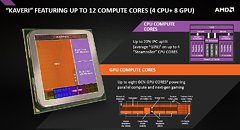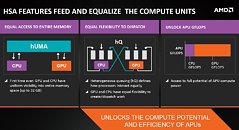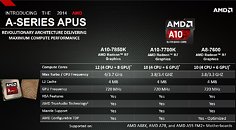Tuesday, January 14th 2014

AMD Announces 4th Generation A-Series "Kaveri" Desktop APUs
AMD announced its 2014 A-Series APU for the desktop platform, code-named "Kaveri," after the southern-Indian river. Built in the new FM2+ package, the APUs run only on socket FM2+ motherboards based on the AMD A88X, A78, and A55 chipsets; while the socket itself can seat older FM2 APU families, "Trinity" and "Richland." In many ways, the socket transition is similar to that of socket AM3+. "Kaveri" sees AMD integrate two of its newest CPU and GPU micro-architectures, "Steamroller" for CPU, and Graphics CoreNext 2.0 for the GPU. "Kaveri" is also built on newer generation 28 nm silicon fab process.
"Steamroller" is an evolution of the same modular CPU core design as its predecessors, "Piledriver" and "Bulldozer." AMD promises a 10 percent improvement in performance clock-by-clock, per core, which falls in line with AMD's normal scheme of annual incremental performance updates on its CPU micro-architectures. A "Steamroller" module is a combination of two 64-bit x86 cores, which feature dedicated and shared components. "Kaveri" has two such modules, and so physically, it features a quad-core CPU.The GPU inside A-Series "Kaveri" APUs is the fastest AMD ever crammed into a PC APU, although it doesn't come close to the APUs that drive Xbox One and PlayStation 4. Based on the Graphics CoreNext 2.0 micro-architecture, "Kaveri" features eight GCN compute units (CUs), which make up 512 stream processors, and 32 TMUs. The GPU supports DirectX 11.2, OpenGL 4.3, and Mantle. The GPU component also accelerates AMD's TrueAudio technology, which debuted with the Radeon R9 290 series. The GPU's display I/O lets you drive Ultra HD (3840 x 2160 pixels) displays with 60 Hz refresh rates, over DisplayPort 1.2. It supports up to four display outputs.
Moving on to the uncore portion of "Kaveri," AMD deployed a new-generation integrated memory controller (IMC). It supports up to 64 GB of dual-channel DDR3-2400 MHz memory. Its biggest feature id hUMA (heterogeneous unified memory access), which not only chucks out fixed memory partitions between the system and shared graphics memory area, but also makes the CPU and GPU access the same memory simultaneously. This should translate to greater system memory available to the OS (as "hardware reserved" GPU memory is eliminated), and better GPGPU performance. The second big highlight in the uncore department is the PCI-Express root complex, which now gives out up to 24 lanes of PCI-Express gen 3.0. This should translate into better CrossFire performance, in which a pair of graphics cards are given an 8-lane PCI-Express link, each.
AMD launched its 2014 A-Series APU family with three models, the A10-7850K, the A10-7700K, and the A8-7600. Specifications of the three parts are tabled below. The A10-7850K and A10-7700K will include Origin keys to Battlefield 4, and the two chips apparently meet the minimum system requirements of the game.
"Steamroller" is an evolution of the same modular CPU core design as its predecessors, "Piledriver" and "Bulldozer." AMD promises a 10 percent improvement in performance clock-by-clock, per core, which falls in line with AMD's normal scheme of annual incremental performance updates on its CPU micro-architectures. A "Steamroller" module is a combination of two 64-bit x86 cores, which feature dedicated and shared components. "Kaveri" has two such modules, and so physically, it features a quad-core CPU.The GPU inside A-Series "Kaveri" APUs is the fastest AMD ever crammed into a PC APU, although it doesn't come close to the APUs that drive Xbox One and PlayStation 4. Based on the Graphics CoreNext 2.0 micro-architecture, "Kaveri" features eight GCN compute units (CUs), which make up 512 stream processors, and 32 TMUs. The GPU supports DirectX 11.2, OpenGL 4.3, and Mantle. The GPU component also accelerates AMD's TrueAudio technology, which debuted with the Radeon R9 290 series. The GPU's display I/O lets you drive Ultra HD (3840 x 2160 pixels) displays with 60 Hz refresh rates, over DisplayPort 1.2. It supports up to four display outputs.
Moving on to the uncore portion of "Kaveri," AMD deployed a new-generation integrated memory controller (IMC). It supports up to 64 GB of dual-channel DDR3-2400 MHz memory. Its biggest feature id hUMA (heterogeneous unified memory access), which not only chucks out fixed memory partitions between the system and shared graphics memory area, but also makes the CPU and GPU access the same memory simultaneously. This should translate to greater system memory available to the OS (as "hardware reserved" GPU memory is eliminated), and better GPGPU performance. The second big highlight in the uncore department is the PCI-Express root complex, which now gives out up to 24 lanes of PCI-Express gen 3.0. This should translate into better CrossFire performance, in which a pair of graphics cards are given an 8-lane PCI-Express link, each.
AMD launched its 2014 A-Series APU family with three models, the A10-7850K, the A10-7700K, and the A8-7600. Specifications of the three parts are tabled below. The A10-7850K and A10-7700K will include Origin keys to Battlefield 4, and the two chips apparently meet the minimum system requirements of the game.




50 Comments on AMD Announces 4th Generation A-Series "Kaveri" Desktop APUs
Now if only we could get a Steamroller CPU(no graphics) on FM2+ and why not, maybe with more than 2 modules.
foro.noticias3d.com/vbulletin/showthread.php?t=421821
Funny to think we've come full circle. From the GPU makers developing the 3D drivers/etc to just the OS devs handling it. Now AMD is back to it with Mantle. Wonder how long till nVidia does the same. Course if it means M$ won't hold a monopoly over drivers and force people to update to new Windows to get new DX capabilities then that is good. Time will tell.
AMD should've started the Bulldozer project 2 years earlier but there is no time machine in sight yet.
A7700K ~155 Euro:
A7850K ~177 Euro:
www.pcgarage.ro/procesoare/amd/kaveri-a10-x4-7700k-black-edition-35ghz-box/
www.emag.ro/procesor-amd-kaveri-a10-7700k-3400mhz-socket-fm2-box-ad770kxbjabox/pd/DMYLSBBBM/
www.emag.ro/procesor-amd-kaveri-a10-7850k-3700mhz-socket-fm2-box-ad785kxbjabox/pd/DBYLSBBBM/
Phenom's had 6 real cores and did fine with that.
Or is it still too early.
has gloflo even been ready for mass large high end 28nm?
I laugh at people hating on these little things, because they've never used them. Played BF3 and all those games on a 750K, and when paired with a high end GPU, I could eat games alive on 1440p. Guess people just don't know what they're talking about...
EDIT: Granted I don't recommend these to anyone playing Total War though!
Nice to see improvements in power consumption though...